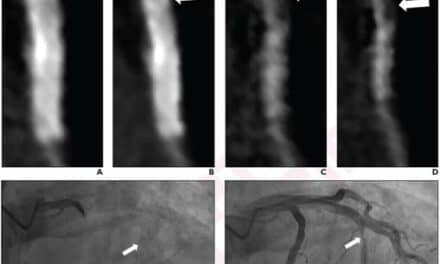By Jenny Lower
It’s a good time, technologically speaking, to be a medical imaging outlier. Patients whose health conditions have traditionally challenged conventional CT techniques—due to arrhythmia, renal insufficiency, age, or illness—have spurred innovations to overcome these obstacles without compromising image quality. At the same time, vendors have shown their commitment to patient comfort and safety by reducing radiation dose, driving the industry forward. All in all, the newest CT products offer more than just the latest bells and whistles, but rather aim to fill real voids in clinical care. Here is a glimpse of some of what Axis Imaging News spotted at RSNA 2013.
Revolution CT from GE Healthcare
Following the largest investment in the company’s history, GE has developed a 510(k)-pending scanner that captures an image of the human heart in a single beat. The Revolution CT combines wide coverage, high spatial resolution, high temporal resolution, and low dose into a single system. According to the manufacturer, the new machine permits patients who might have been disqualified from CT scans in the past—due to rapid heart rate or inability to hold still—to now undergo scanning that produces high-quality diagnostic images.
The 16 cm Gemstone Clarity detector provides whole organ coverage with spatial resolution at 230 microns to capture small anatomy. A 0.28-second gantry offers up to 0.2-second rotation speed, while SnapShot Freeze enables intelligent motion correction on a system that provides 24 millisecond temporal resolution. Patients recline on an 80 cm bore as Whisper Drive technology affords a muted scanning experience. To cut down on radiation dose, GE has introduced new features like the Gemstone Clarity detector, a 70 kVp scan mode for children, and the ASiR-V, the latest version of the company’s iterative reconstruction technology. The range of features enables comprehensive cardiac exams, whole-brain stroke assessment, and dynamic liver, kidney, or pancreas oncology workups personalized with perfusion and vascular flow analysis. The system’s fast speed also makes it well suited for an emergency department setting.
SOMATOM Force from Siemens Healthcare
Siemens’ next-generation CT scanner includes features that address the needs of the most challenging patients, including those with rapid heartbeat, renal insufficiency, or lung cancer. At 737 mm per second, the SOMATOM Force boasts the fastest acquisition rate on the market, allowing a full chest and abdomen analysis in one breath. The system has captured diagnostic-quality images for patients with heart rates of 90 beats per minute without using beta blockers. A Turbo Flash Mode switches over to a 50-cm field of view while still maintaining a 400 mm acquisition rate. For elderly or ill patients whose kidneys cannot process typical doses of contrast agent, the SOMATOM Force’s low-voltage Vectron x-ray tubes permit levels as low as 25 to 35 mL.
A National Cancer Institute study also has shown that low-dose CT can reduce lung cancer mortality rates by 20% compared to standard x-ray procedures. According to the manufacturer, the SOMATOM Force is particularly well suited to this application as Siemens’ Selective Photon Shields optimize the x-ray spectrum to improve air and soft-tissue contrast, reducing radiation dose up to 50% compared to similar CT systems. The SOMATOM Force is currently pending 510(k) clearance.
IQon Spectral CT from Philips Healthcare
The world’s first spectral-detector CT system built specifically for spectral imaging, the 510(k)-pending IQon transforms traditional CT by permitting clinicians to detect an image’s composition and anatomical structure in a single scan. For example, the system can identify iodine and calcium. It can be useful in determining kidney stones and characterizing plaques. Just as a prism fragments white light into its components, a new spectral detector discriminates between high- and low-energy x-ray photons simultaneously. The technology allows the system to automatically generate a color image that is then stored in the system and accessible at any time via Philips’ iPatient platform. Clinicians can interpret the system’s conventional grayscale images knowing they can reference additional data without turning to additional procedures. The result is fewer, more detailed scans, improving diagnostic accuracy and patient safety while maximizing throughput.
Adaptive Diagnostics CT Technology from Toshiba
Enhancing its line of Aquilion CT scanners, Toshiba has released a suite of new technologies to improve image clarity and lower patient dose. Metal Artifact Reduction eliminates the streaking residue created by the presence of metal implants in the body, while SURESubtraction allows clinicians to edit out bone or calcium and zoom in on tumors and endangered arteries. Pending FDA clearance, SURESubtraction is available for bone, brain, carotid, and coronary artery exams. To reduce radiation exposure, SURECardio Prospective with arrhythmia detection replaces the series of images required during CTA exams with a single continuous image captured via helical technology. The software automatically compensates for patients with irregular heartbeats, producing a final diagnostic image faster with far less radiation. Variable Helical Pitch can change an ECG-gated to a non-ECG-gated acquisition, reducing IV contrast and radiation dose, while also lowering radiation dose over the use of a single-gated pitch setting. Dual Energy doubles the amount of data harvested during a CT exam, helping clinicians quantify and characterize anatomy and lesions, reducing exam time and radiation dose. The upgraded features are available on Toshiba’s Aquilion ONE, Aquilion ONE ViSION Edition, and Aquilion PRIME. Metal Artifact Reduction, SURESubtraction, and Dual Energy are FDA pending.





